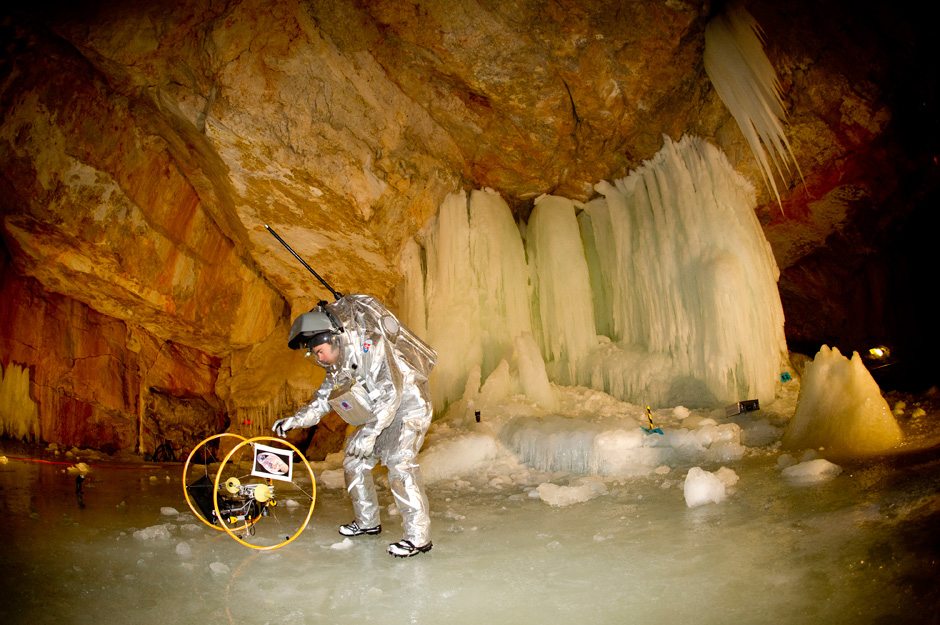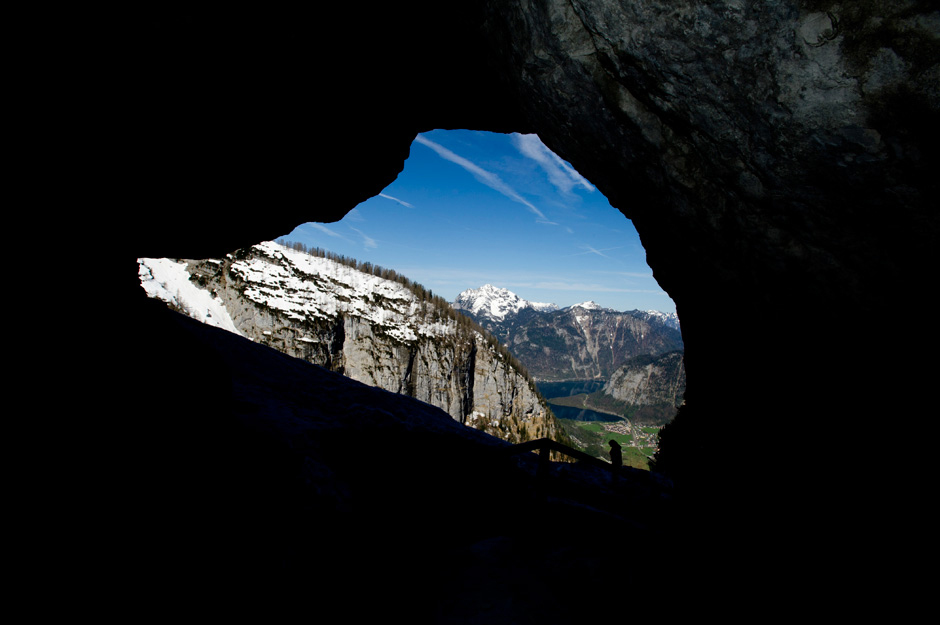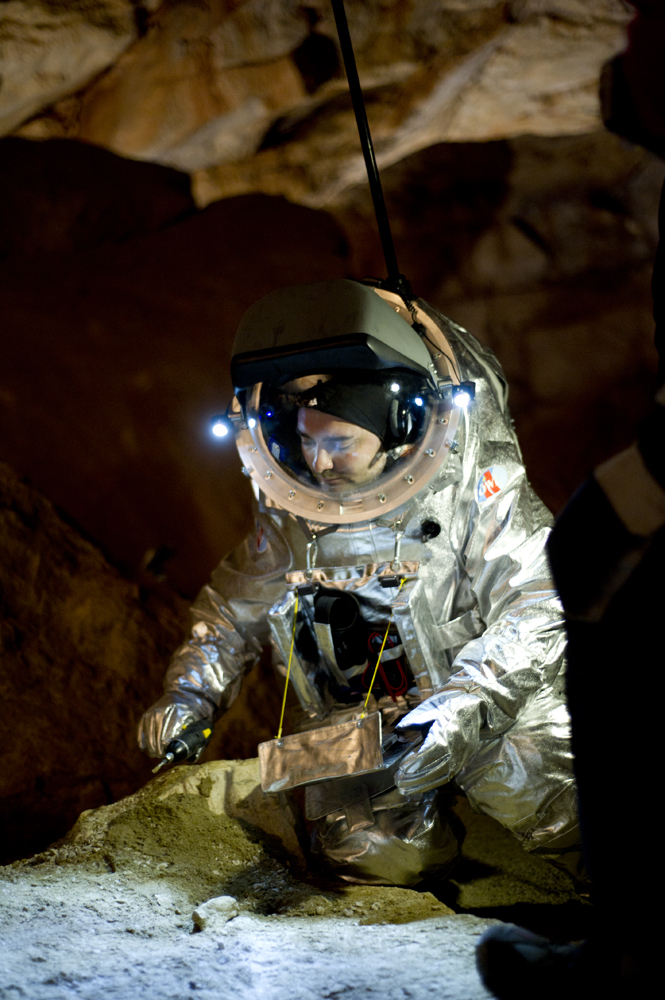Mock Mission to Mars Takes Scientists to Austrian Ice Caves

In the largest ice caves on Earth, spacesuits and remote-controlled planetary rovers were for the first time tested in a five-day odyssey in the Alps designed to mimic potential future missions on Mars.
Scientists have long wanted to investigate Martian caves for life. Temperatures within such caves are very stable, and perhaps would be friendly to life. Caverns might also provide a more hospitable level of humidity than seen on the extraordinarily dry surface of Mars, and provide shelter against radiation from space.
"They would be a natural retreat for life, if it ever arose on Mars," said astrobiologist Gernot Grömer, president of the Austrian Space Forum, the agency that led the experiments in the caves. As such, researchers wanted to investigate caverns with space exploration gear to see how it handled the varied terrain within.
Researchers targeted the Eisriesenwelt — German for the "World of the Ice Giants" — a labyrinth of caves in the Dachstein region of Austria that stays cold enough to freeze any water inside year-round, causing gigantic ice formations to grow within. Explorers might find either conventional limestone caves or ice-covered caverns or both on the Red Planet, "so basically the Dachstein Ice Caves offered nearly every terrain type we could think of on Mars," Grömer said.
In a freezing cold cave 4,265 feet (1,300 meters) above sea level, from April 27 to May 1, the Austrian Space Forum, in partnership with NASA's Jet Propulsion Laboratory and other researchers from 11 countries on three continents, ran a battery of experiments meant to test the limits of potential Martian exploration technology. [Mock Mars Mission Explores Austrian Ice Caves (Pictures)]
"The Dachstein mission gave us a glimpse of what one day could become a part of history," Grömer told Astrobiology Magazine.

Spacesuit
Get the Space.com Newsletter
Breaking space news, the latest updates on rocket launches, skywatching events and more!
To simulate how astronauts might fare on the Red Planet, volunteers donned the shiny Aouda.X suit, an outfit designed to protect its wearer from a harsh alien world and simulate work on Mars. The 100-lbs. (45-kilogram) system took two hours to put on — its outer hull is made of aluminum-coated Kevlar-Panox textile, which creates an excellent thermal and biological barrier while maintaining mechanical strength.
Exploring another world can be hazardous work, and so the suit is designed to monitor its user. The innards were equipped with a complete sensory network that monitored the suit-tester's health, including body temperature, heart rate, and carbon dioxide and oxygen levels. At the same time, a flight controller monitored the health of the suit, including computer processor temperatures.
Although the simulator was not truly airtight like a real spacesuit, it could mimic all the major limitations a real suit on Mars would have, such as diminished sensory perception and the lower atmospheric pressure on the Red Planet. However, it also offered advantages of modern human-machine interfaces, such as voice command and gesture recognition.
Astronauts are almost never really alone on missions. As such, researchers kept volunteers in the spacesuit connected over radio to researchers overseas, who, via audio and video links, directed the volunteers to desired locations to collect ice and other samples.
Rovers
In addition to potential human explorers of space, researchers also tested a small fleet of rovers destined to explore other worlds. These included:
- The Asimov rover of the Part-Time Scientists team in Germany, a competitor for the Google Lunar X Prize. The contest aims to land a rover on the Moon, have the rover travel about 1,600 feet (500 meters) on the lunar surface and transmit high-definition resolution images and video back to Earth.
- The Magma White rover of the Polish Mars Society. The machine was equipped with the WISDOM (Water Ice Subsurface Deposit Observation on Mars) ground-penetrating radar system developed by LATMOS in France, which is intended to provide a detailed view of the top few yards of the Martian subsurface when incorporated into the European Space Agency's 2018 ExoMars rover.
- Dignity, the first rover from the Austrian Space Forum, which is equipped with solar modules, pivoting cameras and a remote-controlled robotic arm.
- The Cliff Reconnaissance Vehicle (CRV) of the French Mars Society, a "cliffbot" that maneuvers up and down cliffs with the aid of a cable.
- Two aerial vehicles as flying cameras. The smaller one, a Quadrocopter drone, was able to fly within the cave to scout for potentially hazardous terrain. "We got aerial reconnaissance within the larger cave systems," Grömer said. "This would be in principle also thinkable for Mars, as there is less gravity, and with engineering modifications, aerial vehicles could be possible on the Red Planet." The larger vehicle, an electrical helicopter, took aerial shots outside the cave for outreach purposes.
One lesson learned regarding rovers was the great benefit of having a wheeled vehicle on flat surfaces and the cable-climbing cliff-bot for steep surfaces. "If we could combine those into one vehicle, that'd be highly interesting," Grömer said. "In fact, we are studying this option for a future field test."
Challenges
The suit posed a number of challenges its wearers had to overcome that might otherwise have been difficult to anticipate in the laboratory. For instance, the communications headset of one of the wearers, graduate student Daniel Föger, slipped down his face while he was crouching, and his helmet had to be opened up in the cave to fix it — something not possible if on the harsh surface of Mars. Although the suit has a backup radio system independent of the headset, such a mishap is nevertheless something future researchers would like to avoid, and the crew fixed the problem by taping on the headset.
More serious challenges were posed by rough, narrow, low terrain, slippery ice and the physically and mentally exhausting nature of the work. In addition, as cold as the caves were, excessive heat often built up inside the suit, and short breaks were needed for its thermal control system to cool it down.
Moreover, in order to find alien life on distant worlds, scientists have to make sure anything they discover is not actually germs from Earth. The researchers experimented with how much potential astronauts might contaminate their surroundings using miniature luminescent beads on their gloves to simulate microbial spores that people might have brought from home.
"Every mistake we uncover during these simulations we will hopefully avoid on Mars," Grömer said.

Lessons
In general, "working with the spacesuit simulator and all the rovers and instruments in this ice-covered site was like getting a first feeling what it would be on the Red Planet if we hit an ice reservoir in a subsurface setting for the first time," Grömer said. "It would certainly be an astrobiologist's dream."
The experiments at the ice caves generated tons of data the researchers will spend the next few months analyzing. They hope to present their ice cave data at the Mars Analog Conference in Morocco in October, Grömer said.
Still, the scientists have already learned a number of valuable lessons when it comes to future missions on Mars.
"At this point, the most important lesson learned is that, yes, we can do subsurface exploration, but we need to adjust our way of conducting Mars exploration significantly," Grömer said. For example, missions to Mars will have to become far more field-oriented as opposed to directed from crews on Earth, due in part to delays experienced for communication between the planets. The long distance between Earth and Mars means there can be a lag of more than 20 minutes just for one-way messages.
"The scientific decision-making process has to be shifted towards the flight crews," Grömer said.
In addition, although human and robotic space exploration are often pitted against each other as rivals, "we realized that rovers and humans do not compete, but rather are complementary to each other," Grömer said. "Robots are great for scouting and reconnaissance, but humans are much more versatile in conducting experiments. So, send them both."
The researchers plan to next test space exploration gear in the northern Sahara in Morocco in February 2013. The deadline for submissions for those experiments is June 15.
This story was provided by Astrobiology Magazine, a web-based publication sponsored by the NASA astrobiology program.
Join our Space Forums to keep talking space on the latest missions, night sky and more! And if you have a news tip, correction or comment, let us know at: community@space.com.

Charles Q. Choi is a contributing writer for Space.com and Live Science. He covers all things human origins and astronomy as well as physics, animals and general science topics. Charles has a Master of Arts degree from the University of Missouri-Columbia, School of Journalism and a Bachelor of Arts degree from the University of South Florida. Charles has visited every continent on Earth, drinking rancid yak butter tea in Lhasa, snorkeling with sea lions in the Galapagos and even climbing an iceberg in Antarctica. Visit him at http://www.sciwriter.us










